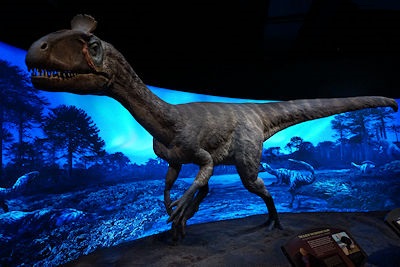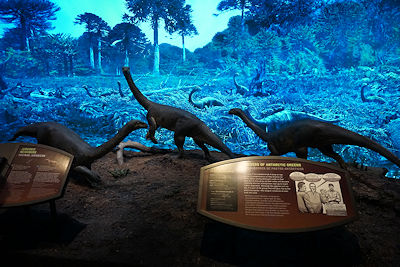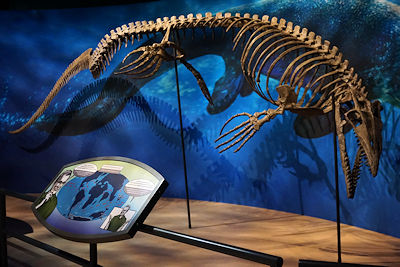
During the Triassic Period, the extraterrestrials known as the Nuwali created a tropical enclave in Antarctica, surrounded by active volcanos and hidden from the rest of the world. It began as a scientific experiment on behalf of another alien race – the nigh-omnipotent Beyonders – who wanted to observe evolution within a controlled environment.
The research study was later abandoned but its collection of prehistoric life, which included dinosaurs, was later re-discovered and incorporated into the Marvel Comics Universe. Now named the Savage Land, the area has been visited by everyone from Spider-Man to Agents of S.H.I.E.L.D. ever since the 1960s.
Although not currently tropical nor surrounded by active volcanos, the real world James Ross Island was once a “savage land” as well. Situated in the farthest northern section of the Antarctic Peninsula, this small landmass was formerly home to plant-eating Ankylosaurs called Antarctopelta and meat-devouring Cryolophosaurus during a time when Antarctica was far from the frozen tundra that it is today.
Beginning in 1986 – the year that Argentinian geologists Eduardo Olivero and Roberto Scasso uncovered the first dinosaur fossil on James Ross Island – paleontologists have been fascinated with the Antarctic, arguably the last place on the planet that one would expect to find prehistoric remains.
In 2010, a team of paleontologists – led by Nathan Smith from the Natural History Museum of Los Angeles and Pete Makovicky from the Field Museum in Chicago – embarked on an expedition to Mount Kirkpatrick in Antarctica to search for additional evidence that dinosaurs once roamed the continent. Their adventures and discoveries were subsequently transformed into Antarctic Dinosaurs, a traveling exhibit that premiered at the Field in 2018 before making its way to Los Angeles and Discovery Place Science in Charlotte, North Carolina.
“It’s an adventure story about the history of Antarctic exploration from nearly a century ago to present day,” Lori Bettison-Varga, president of the Natural History Museum in Los Angeles, explained in regards to the exhibit. “But it’s also a story about how this work provides insights into climactic and ecologic change on our planet.”
The existence of a large landmass at the south pole was initially speculated by the prolific Greek scientist Claudius Ptolemy in the first century, but it wasn’t until the eighteenth century that the belief became more than hypothetical. British explorer James Cook ventured across the Arctic Circle in both 1773 and 1774 before turning back due to a massive sea of ice, and separate journeys by the British, Russians, and Americans in the 1820s provided additional confirmation.
In 1911, Norwegian Roald Amundsen was the first human to make his way to the literal South Pole, followed one month later by British native Robert Scott, who perished along with the rest of his team on the return journey. It wasn’t until 1956 that the feat was again duplicated, this time by American George Dufek via the air rather than land.
Exploration of Antarctica began in earnest during the early 1990s, uncovering clues regarding the evolution of the region in the process. Three hundred million years ago, all current continents were connected into a supercontinent known as Pangea. By the time of the Triassic Period, however, Antarctica was already beginning its present-day transformation with extended periods of darkness during the winter months and cooler temperatures.
Still substantially warmer than in contemporary times, prehistoric Antarctica was covered with thick, flatland forests that featured trees towering above and peat swamps below. Lifeforms during this time period included the crocodile-like Antarctosuchus, a semi-aquatic amphibian with tiny teeth that hunted invertebrates and small fish.
Once the Jurassic Period arrived, so had the dinosaurs. The handful of species that have been uncovered were from the first quarter of that era, meaning that more time passed between the dinosaurs found in Antarctica and the arrival of the Tyrannosaurus rex in North America than the extinction of the T. Rex and today. Antarctic dinosaurs are thus early ancestors of the more familiar therapods and sauropods found in natural history museums across the country and around the globe.
The Cryolophosaurus is a prime example. Initially thought to be a new species, examination of its skull bones revealed similarities to Dilophosaurus, a crested dinosaur from North America. While larger than the earliest dinosaurs – and the largest discovered in Antarctica – Cryolophosaurus still has what the Antarctic Dinosaurs exhibit refers to as “old fashioned” features throughout its spine, hips, and limbs.
During their 2010 expedition, the team led by Nathan Smith and Pete Makovicky excavated large chunks from Mount Kirkpatrick after spotting vertebrae and limb bones protruding through the surface. Their return to the United States offered a better opportunity to dig deeper into these blocks, leading to the discovery of a new dinosaur similar to the Sauropodomorph already uncovered.
Sauropodomorph is an early ancestor of the behemoth Brachiosaurus and Diplodocus sauropods who had long necks and pillar-like legs. Other dinosaur fossils discovered in Antarctica share similarities with Plateosaurus and Coelophysis – although, like with the Cryolophosaurus and Sauropodomorph, each is an earlier version of those found elsewhere on the planet.
As Pangea broke apart and Antarctica drifted south, the climate on the continent began to change in earnest, a transformation that accelerated when Earth’s overall temperatures dropped dramatically. Despite its isolated location and frigid environment, however, scientists continue to study Antarctica nonetheless, hoping to gain insights into not only its past but present and future as well.
Given its metamorphosis from tropical to arctic, an analysis of Antarctica offers clues to the potential effects that climate change may have on our planet. The ice sheets that cover the region contain 61 percent of the world’s water supply, for instance, and any fluctuations in arctic temperatures could result in sea levels rising as much as 200 feet.
The barren, inhospitable landscape likewise offers new understanding regarding the future of space exploration, with Antarctica substituting for such barren and inhospitable planets as Mars. Given how little of the Antarctica landmass has actually been traversed, scientists are using advanced satellites to map the terrain and determine the thickness of the ice that covers the region.
As the human race gains further insights into Antarctica, a deeper understanding of the world in general begins to formulate as well. And as the efforts of Nathan Smith and Pete Makovicky, their team of fellow paleontologists, and the resulting Antarctic Dinosaurs exhibit makes clear, that understanding pertains to the Jurassic World just as much as any other – even if the region itself is no longer a “savage land.”
Anthony Letizia





